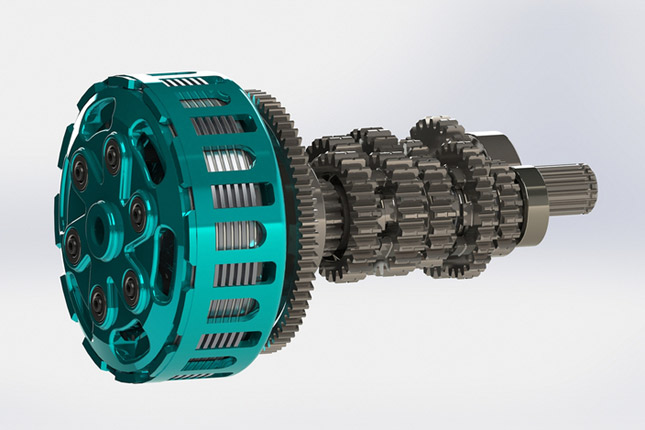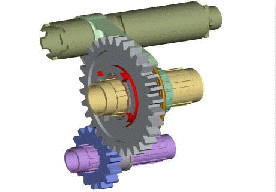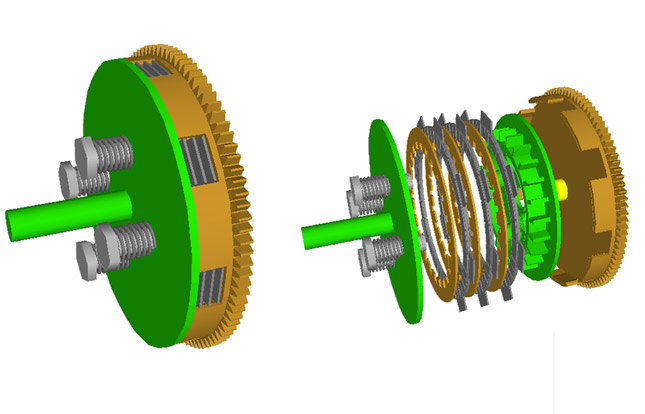Riding a motorbike is an Art as much as it is a science. Only a true motorcycle enthusiast can understand the joy of pulling up the clutch lever and downshifting the gear in a right slot with a perfect timing. We all know about transmission of a bike and we also aware of "Clutch" but do we know everything about Clutch? How it works? what is the significance it bears?
I will try to explain the working of Motorcycle Clutch with all of its salient features and important aspects in simple terms.
Clutch:
 Working Of Clutch:
Working Of Clutch:
To understand the working of clutch it is important to know about the basics of the transformation of energy (rotary movement) from the engine to the final drive or the rear wheel of the motorbike. In a simple way you can understand it better, that the power generated as a result of burning of fuel and air mixture in the combustion chamber goes to the crankshaft passing through the up n down movement of piston.
Now imagine the crankshaft is rotating at a 5000 revolution per minute (RPM) even at idle, has to further transmit the energy to the final drive (drive chain) or rear wheel via transmission box. The transmission box has series of gears which are commonly called as "Constant Mesh" because they are closely placed and are in continuously contact with each other.
Normally the transmission remains in neutral, which means the gears are not engaged with the crankshaft although the engine is still running and the crankshaft is rotating at regular speed. To engage the gear with the rotating crankshaft you can not directly cog the gear and even if you do so for the sake of it, you know the result. The bike will stall with sudden engagement of gear and eventually the engine stops running. There must be a device which can facilitate this engagement of gears with the engine and here comes the "Clutch" into play. The clutch is consists of clutch plates (friction plates + steel plates) and clutch hub with pressure plates and springs. The clutch assembly is put in between the transmission and the input shaft coming from the crankshaft. The entire clutch assembly helps to separate the input shaft and the transmission when depressed completely.
There must be a device which can facilitate this engagement of gears with the engine and here comes the "Clutch" into play. The clutch is consists of clutch plates (friction plates + steel plates) and clutch hub with pressure plates and springs. The clutch assembly is put in between the transmission and the input shaft coming from the crankshaft. The entire clutch assembly helps to separate the input shaft and the transmission when depressed completely.
The depression of the clutch forces the springs to compress and resulting into loosening of the contact of the friction plates and the steel plates allowing the flywheel to rotate freely. This is the time when you can choose the right gear according to the speed you are at currently or the power band you want to be in. You can actually feel the engagement of the gear and on releasing the clutch you can also feel the contact of the friction plates as well. Advantages & Disadvantages Of Clutch:
Advantages & Disadvantages Of Clutch:
There are many advantages of Clutch and very few disadvantages are in existence;
The Engine Braking is fatal at high speed cornering and specially is a matter for concern for the sportbikes participating in professional biking events. As the more powerful engine it is the more engine braking effect it can experience. To overcome this phenomenon another type of clutch came into existence- Slipper Clutch. The slipper clutch is specially designed for the latest sport machines capable of doing very high speeds. The comfort and the efficiency of the Slipper Clutch soon become very popular and now it is a common feature in even smaller displacement sportbikes like Kawasaki Ninja 300.
We will discuss the working of Slipper Clutch in detail in our upcoming article, so stay tuned and keep watching the space. I Hope what we have discussed now have brought some clarity to you about the concept of Clutch. Please share your comments on the article.
Animation Credit: Mike Challenger, Haydndesign ltd.
By: Farhan Kashif
I will try to explain the working of Motorcycle Clutch with all of its salient features and important aspects in simple terms.
Clutch:
Definition: The Clutch is a mechanical device and it is responsible for engaging and disengaging the engine crankshaft with transmission gears.
 Working Of Clutch:
Working Of Clutch: To understand the working of clutch it is important to know about the basics of the transformation of energy (rotary movement) from the engine to the final drive or the rear wheel of the motorbike. In a simple way you can understand it better, that the power generated as a result of burning of fuel and air mixture in the combustion chamber goes to the crankshaft passing through the up n down movement of piston.
Now imagine the crankshaft is rotating at a 5000 revolution per minute (RPM) even at idle, has to further transmit the energy to the final drive (drive chain) or rear wheel via transmission box. The transmission box has series of gears which are commonly called as "Constant Mesh" because they are closely placed and are in continuously contact with each other.
Normally the transmission remains in neutral, which means the gears are not engaged with the crankshaft although the engine is still running and the crankshaft is rotating at regular speed. To engage the gear with the rotating crankshaft you can not directly cog the gear and even if you do so for the sake of it, you know the result. The bike will stall with sudden engagement of gear and eventually the engine stops running.
 There must be a device which can facilitate this engagement of gears with the engine and here comes the "Clutch" into play. The clutch is consists of clutch plates (friction plates + steel plates) and clutch hub with pressure plates and springs. The clutch assembly is put in between the transmission and the input shaft coming from the crankshaft. The entire clutch assembly helps to separate the input shaft and the transmission when depressed completely.
There must be a device which can facilitate this engagement of gears with the engine and here comes the "Clutch" into play. The clutch is consists of clutch plates (friction plates + steel plates) and clutch hub with pressure plates and springs. The clutch assembly is put in between the transmission and the input shaft coming from the crankshaft. The entire clutch assembly helps to separate the input shaft and the transmission when depressed completely.The depression of the clutch forces the springs to compress and resulting into loosening of the contact of the friction plates and the steel plates allowing the flywheel to rotate freely. This is the time when you can choose the right gear according to the speed you are at currently or the power band you want to be in. You can actually feel the engagement of the gear and on releasing the clutch you can also feel the contact of the friction plates as well.
 Advantages & Disadvantages Of Clutch:
Advantages & Disadvantages Of Clutch:There are many advantages of Clutch and very few disadvantages are in existence;
- Without clutch you can not virtually put your bike's engine into gear, specially when the bike is stand still without any momentum. However with precise timing and practice you can do it while moving but it is not recommended as wrong timing may result into broken gear or entire broken gear assembly.
- Clutch allows you to stop at any speed by disengaging the engine
- It may also prove to be life saving device in case of engine seizure as by depressing the clutch you can avoid the sudden arrest of the bike which would be 100% fatal at high speed.
- The working of clutch is simple yet effective but the conventional clutch has its limitations that specially come into foreplay when we talk about high speed maneuverability like in Superbikes. No matter how precisely you use the clutch and change the gear there is an "Engine Braking" effect come into play. This engine braking is experienced more when you upshift gear, it is due to the difference between the engine speed and the speed of the bike.
The Engine Braking is fatal at high speed cornering and specially is a matter for concern for the sportbikes participating in professional biking events. As the more powerful engine it is the more engine braking effect it can experience. To overcome this phenomenon another type of clutch came into existence- Slipper Clutch. The slipper clutch is specially designed for the latest sport machines capable of doing very high speeds. The comfort and the efficiency of the Slipper Clutch soon become very popular and now it is a common feature in even smaller displacement sportbikes like Kawasaki Ninja 300.
We will discuss the working of Slipper Clutch in detail in our upcoming article, so stay tuned and keep watching the space. I Hope what we have discussed now have brought some clarity to you about the concept of Clutch. Please share your comments on the article.
Animation Credit: Mike Challenger, Haydndesign ltd.
By: Farhan Kashif











